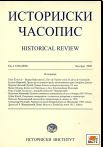Рудник под османском влашћу у XV и XVI веку
Rudnik under the Ottoman Rule in the 15th and 16th Centuries
Author(s): Srđan KatićSubject(s): History
Published by: Istorijski institut, Beograd
Keywords: Ottoman Empire; Rudnik; mining; metallurgy; silver
Summary/Abstract: Rudnik was one of the oldest mines and squares n the Serb Medieval state, for the first time mentioned in 1293. It was a silver mine, but also produced considerable quantities of copper and lead. Rudnik was considered as a big silver mine, although not of the size of Novo Brdo and Srebrenica. The 1458 Ottoman conquest did not bring significant changes in the everyday life of the population. Local authorities still had an important role, and the existing mining codes and common law continued to be implemented. For decades, the presence of Ottoman Turkish authorities was limited to a small garrison in the nearby Ostrovica fort, along with a few clerks, who controlled mining operations and tax collection. During the Turkish rule, main mining operations on the Rudnik mountain were around the town of Rudnik, near the present-day village of Majdan. The most successful period in Rudnik's history was interrupted by the plague epidemics, which hit hard Rudnik and the surrounding mining settlements during 1520s and 1530s.However, religious differences did not present an obstacle for the common business of the adherents of different religions. It was not uncommon for the clerks of different religious affiliations to be members of the mine's management, to be co-owners of mining and melting premises, or members of the same mining associations.The rises and fallings of Rudink, caused by epidemics and hardship, continued for the most of the 17th century. In that period, the Muslim community was much more numerous than the Christian one, and Rudnik was considere to be a medium-sized mine. During the Vienna War, and the battles between Austrian and Turkish armies on the territory of the present-day Serbia (1688-1690), Rudnik was devastated, and most of its inhabitants were either killed, or emigrated. Thus ceased the organized mining production in one of the oldest and most important Serbian mines.
Journal: Историјски часопис
- Issue Year: 2007
- Issue No: 55
- Page Range: 133-155
- Page Count: 23
- Language: Serbian

